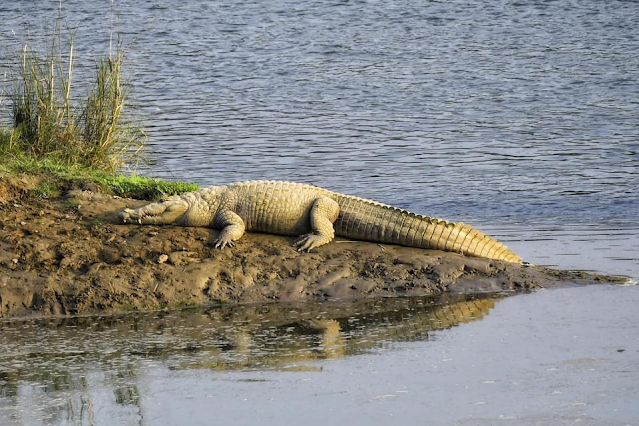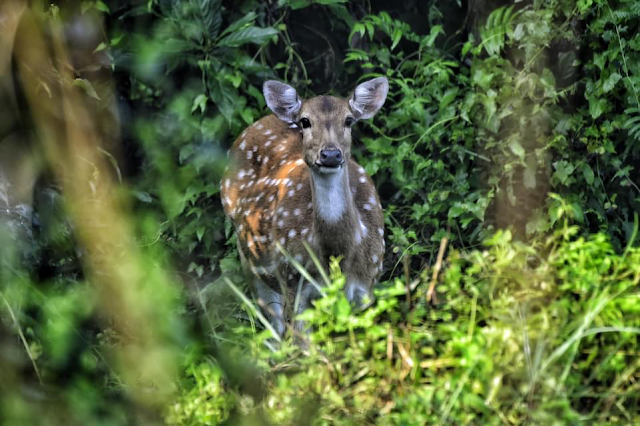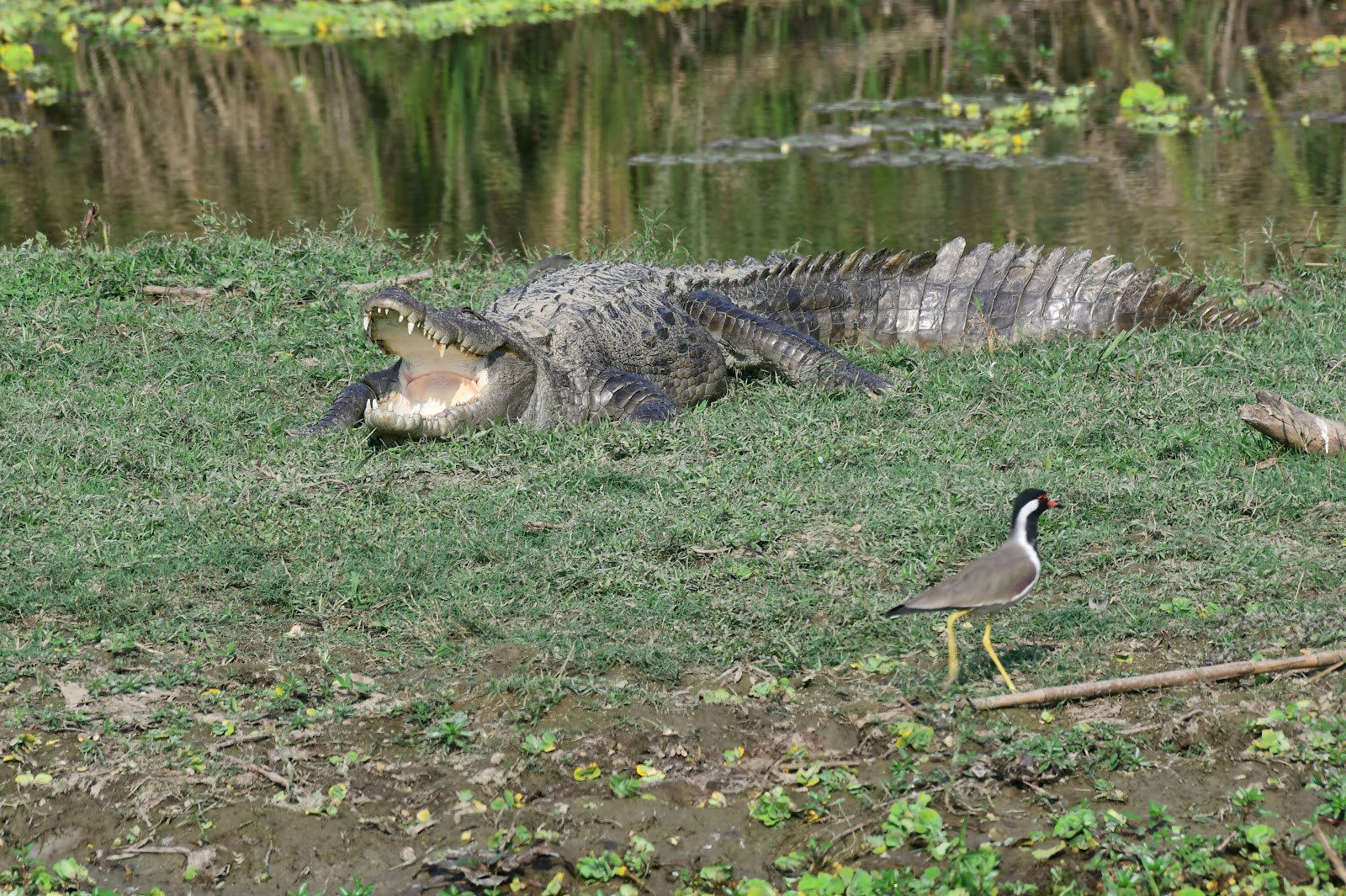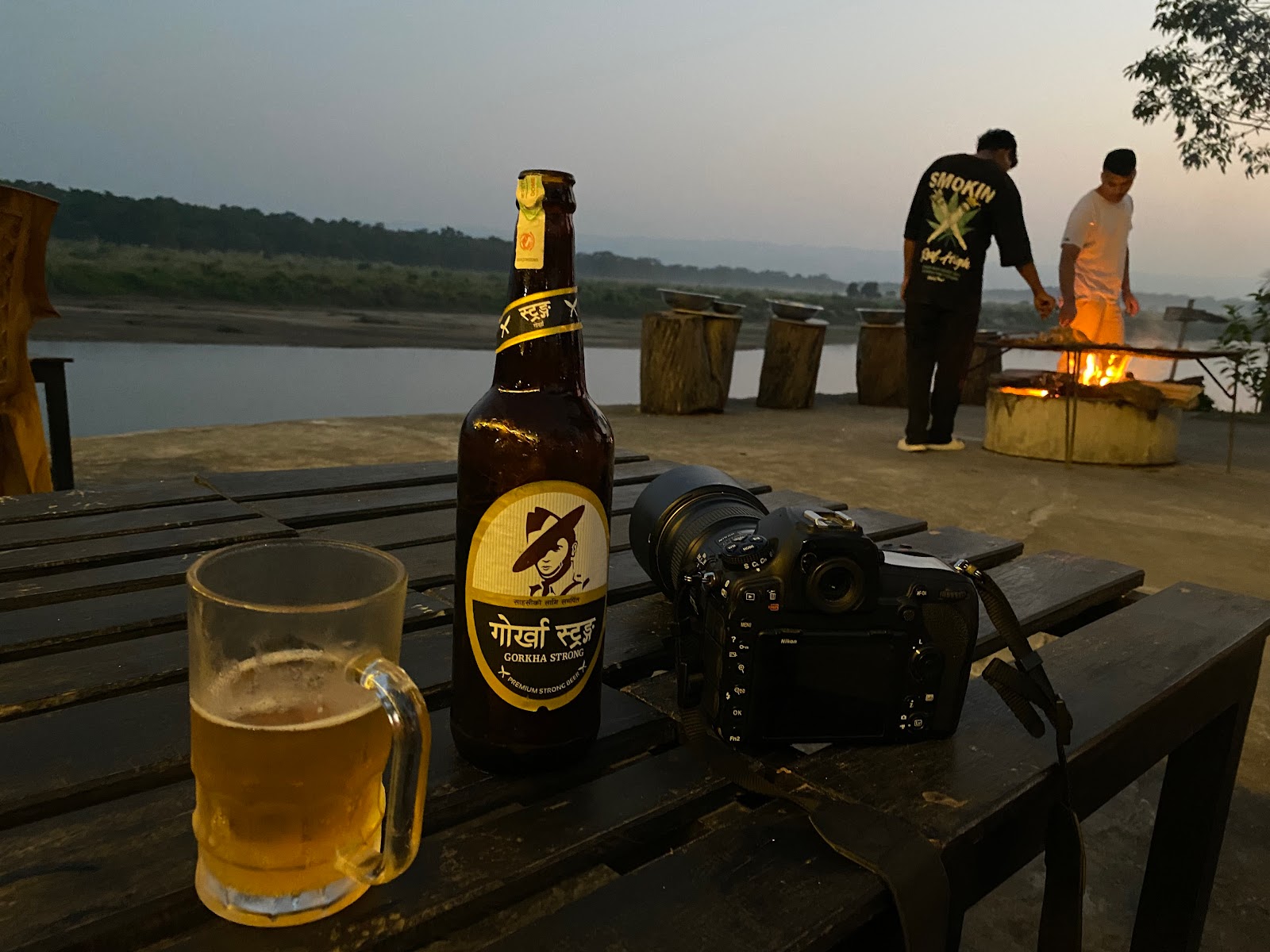Chitwan National Park
อุทยานแห่งชาติจิตวันเป็นอุทยานแห่งชาติแห่งแรกของประเทศเนปาล ก่อตั้งขึ้นเมื่อปี พ.ศ. 2516 ในฐานะอุทยานแห่งชาติ Royal Chitwan และได้รับสถานะเป็นมรดกโลกในปี พ.ศ. 2527 ครอบคลุมพื้นที่ 952.63 ตารางกิโลเมตร (367.81 ตารางไมล์) ในที่ราบลุ่มเขตอินเนอร์เทอรายกึ่งเขตร้อนทางตอนใต้ตอนกลางของประเทศเนปาล ในเขต Nawalpur, Chitwan, Makwanpur และ Parsa มีระดับความสูงตั้งแต่ประมาณ 100 ม. (330 ฟุต) ในหุบเขาแม่น้ำไปจนถึง 815 ม. (2,674 ฟุต) ในเขาศิวาลิก
 |
Chitwan District's administrative center is Bharatpur, the largest city of Nepal after Kathmandu, the commercial and service center of South Central Nepal and a major destination for higher education, health care, and transportation in the region.
Chitwan lies in the Terai region of Nepal. It is in the drainage basin of the Gandaki River and is roughly triangular, taking that river as its meandering northwestern border, and a modest watershed border, with India, as the basis of its southern limit.
จิตวันอยู่ในเขตเทไรของเนปาล อยู่ในแอ่งรับน้ำของแม่น้ำ Gandaki และเป็นรูปสามเหลี่ยมโดยประมาณ แม่น้ำสายนี้เป็นพรมแดนทางตะวันตกเฉียงเหนือที่คดเคี้ยว และเป็นแนวสันปันน้ำเล็กๆ ระหว่างเนปาลกับอินเดีย
Chitwan literally means “heart of the jungle”. The popular Inner Terai valley gets its name from Chitrasen, the Tharu King, who once ruled here. In the southwest corner of Bagmati Province, Chitwan lies between foothills of the Himalaya, the Mahabharat and Siwalik ranges. The region called Chitra Ban in earlier references used to be dense forest abounding in wild animals and resorted by recluse sages meditating deep in the forests.
จิตวัน แปลว่า “หัวใจแห่งป่า” เป็นสถานที่ยอดนิยมแห่งหุบเขาอินเนอร์เทราย ได้ชื่อมาจากกษัตริย์จิตราเสน กษัตริย์ธารู ซึ่งครั้งหนึ่งเคยปกครองที่นี่ จิตวันตั้งอยู่ทางมุมตะวันตกเฉียงใต้ของจังหวัดบักมาตีระหว่างเชิงเขาหิมาลัย เทือกเขามหาภารตะ และเทือกเขาสีวาลิก ภูมิภาคที่เรียกว่าจิตราบันในการอ้างอิงก่อนหน้านี้เคยเป็นป่าทึบซึ่งเต็มไปด้วยสัตว์ป่าและมีนักปราชญ์ผู้สันโดษนั่งสมาธิลึกเข้าไปในป่า
การเดินทางGo4Get@Napal Napal🇳🇵Day2 ขับรถไปจิตวัน ขับรถ 165 กม. จากกาฐมาณฑุไปยังอุทยานแห่งชาติ Chitawon ต้อง ใช้เวลาอย่างน้อย 5 ชั่วโมง เพราะถนนกำลังก่อสร้าง และมีรถใหญ่เบียดกันไปมา แต่วันนั้นใช้เวลาประมาณ 8 ชั่วโมง เพราะเป็นวันเริ่มเทศกาลปีใหม่ของชาวฮินดู ถ้าใครต้องการมาที่นี่แนะนำว่าใช้เครืองบินน่าจะดีที่สุดเพราะประหยัดเวลาได้เยอะมาก

Bharatpur Airport

ถึง Chitawon และเข้า check in ที่ Wildlife adventure resort เกือบเย็น รับเครื่องดื่มต้อนรับและการบรรยายสรุปสั้น ๆ เกี่ยวกับอุทยานแห่งชาติ Chitawan และพักผ่อนตามอัธยาศัย ที่ริมแม่น้ำด้านหลังรีสอร์ทมีนกและตะเข้ตะโขงให้ดูเล่นเพลินๆAsian Woolly-necked StorkCiconia episcopus
Red-naped IbisPseudibis papillosa
A medium-sized ibis with a dark body, often showing a bluish-green sheen. The crown and nape are covered in bright red warts. A white patch is usually visible near the shoulder of the wing. The bill is long and downcurved. This species can be confused with the similar-looking Glossy Ibis, but Glossy Ibis is smaller and lacks the red warts and white shoulder patch. In flight, the legs of Red-naped Ibis don’t extend beyond the tail, unlike in Glossy Ibis. Unlike most other ibis, Red-naped favors drier habitats, such as rye fields. It is usually found singly or in loose groups.
Ruddy ShelduckTadorna ferruginea
Gharial ตะโขง
The gharial (Gavialis gangeticus), also known as gavial or fish-eating crocodile, is a crocodilian in the family Gavialidae and among the longest of all living crocodilians. Mature females are 2.6 to 4.5 m (8 ft 6 in to 14 ft 9 in) long, and males 3 to 6 m (9 ft 10 in to 19 ft 8 in). Adult males have a distinct boss at the end of the snout, which resembles an earthenware pot known as a ghara, hence the name "gharial". The gharial is well adapted to catching fish because of its long, narrow snout and 110 sharp, interlocking teeth.
ตกเย็นไกด์ท้องถิ่นจิตวันจะพาเดินชมชุมชนชาวพื้นเมืองธรุ โดยเดินตามถนนเลียบแม่น้ำ จนพระอาทิตย์ตกดินเจอทั้งจระเข้และแรดนอเดียวที่อยู่ใกล้ชิดคนมากๆจนน่าตกใจ
Mugger
Crocodilus palustris (Lesson)
Local Name: Gohi
The mugger crocodile (Crocodylus palustris) is a medium-sized broad-snoutedcrocodile, also known as mugger and marsh crocodile. It is native to freshwater habitats from southern Iran to the Indian subcontinent, where it inhabits marshes, lakes, rivers and artificial ponds. It rarely reaches a body length of 5 m (16 ft 5 in) and is a powerful swimmer, but also walks on land in search of suitable waterbodies during the hot season. Both young and adult mugger crocodiles dig burrows to which they retreat when the ambient temperature drops below 5 °C (41 °F) or exceeds 38 °C (100 °F). Females dig holes in the sand as nesting sites and lay up to 46 eggs during the dry season. The sex of hatchlings depends on temperature during incubation. Both parents protect the young for up to one year. They feed on insects, and adults prey on fish, reptiles, birds and mammals.
The greater one-horned rhino (or “Indian rhino”) is the largest of the rhino species. Once widespread across the entire northern part of the Indian sub-continent, rhino populations plummeted as they were hunted for sport or killed as agricultural pests. This pushed the species very close to extinction and by the start of the 20th century, around 200 wild greater one-horned rhinos remained.
The recovery of the greater one-horned rhino is among the greatest conservation success stories in Asia. Thanks to strict protection and management from Indian and Nepalese wildlife authorities, the greater one-horned rhino was brought back from the brink. Today populations have increased to around 4000 rhinos in northeastern India and the Terai grasslands of Nepal.
แรดนอเดียว (หรือ "แรดอินเดีย") เป็นแรดที่ใหญ่ที่สุดในสายพันธุ์ การกระจายพันธ์แพร่หลายไปทั่วตอนเหนือของอนุทวีปอินเดีย ปัจจุบันประชากรแรดลดลงเนื่องจากถูกล่าเพื่อกีฬาหรือถูกฆ่าเป็นศัตรูพืชทางการเกษตร สิ่งนี้ผลักดันให้สัตว์ชนิดนี้ใกล้สูญพันธุ์อย่างมาก และเมื่อเริ่มต้นศตวรรษที่ 20 แรดเขาเดียวป่าคงเหลืออยู่ประมาณ 200 ตัว
การฟื้นตัวของแรดเขาเดียวเป็นหนึ่งในเรื่องราวความสำเร็จด้านการอนุรักษ์ที่ยิ่งใหญ่ที่สุดในเอเชีย ต้องขอบคุณการคุ้มครองและการจัดการที่เข้มงวดจากหน่วยงานสัตว์ป่าของอินเดียและเนปาล แรดเขาเดียวที่ยิ่งใหญ่จึงถูกนำกลับมาจากปากเหวปัจจุบัน ประชากรเพิ่มขึ้นเป็นประมาณ 4,000 ตัวในอินเดียตะวันออกเฉียงเหนือและทุ่งหญ้า Terai ของประเทศเนปาล ข้างทางไกด์ชี้ให้ดูต้นไม้ที่คนท้องถื่นเรียกว่าต้นแอปเปิลแรด ประมาณกลางปีต้นนี้จะมีผลคล้ายแอปเปิ้ลที่แรดและสัตว์อื่นๆชอบกินนี่เป็นสาเหตุให้แรดเข้ามาอยู่ใกล้หมู่บ้านมาก
 During tours you can experience the uniquely placed culture of the Tharu people relish what their culture is like in the Tharu Village Museum in the heart of Sauraha Bachhauli. For centuries, the Tharu have lived very closed to this protected area and hence their tradition reflects their intimate relationship with the natural world. Visit the Tharu village and share their world with them as you reach out to touch another culture.
During tours you can experience the uniquely placed culture of the Tharu people relish what their culture is like in the Tharu Village Museum in the heart of Sauraha Bachhauli. For centuries, the Tharu have lived very closed to this protected area and hence their tradition reflects their intimate relationship with the natural world. Visit the Tharu village and share their world with them as you reach out to touch another culture.
ตอนค่ำเรามีโอกาสไปชมการเต้นรำวัฒนธรรมพื้นบ้านชาวธารุ มีการแสดงประมาณ3 แบบ โดยใช้เพลงลูกทุ่งประกอบ Danda Nach (การเต้นรำแบบใช้การตีกระบองไม้มีทั้งชุดผู้ชายและชุดผู้หญิง ) Ago Nach (การเต้นรำแบบควงคบเพลิงไฟ) และMayur Nach (การเต้นรำนกยูง) ถือเป็นไฮไลท์ยอดนิยมของการแสดงวัฒนธรรม
Tharu Cultural Programs and Stick Dance
The Tharu Culture Program organized at Sauraha and Meghauli plays a significant role to entertain the tourist visiting Chitwan National Park and to introduce the Tharu Culture and tradition to the tourists. Majority of the tourist arriving at Chitwan have experience the Tharu culture program.
Spectators get full entertainment by the Tharu dances. Dances like Danda Nach (Stick Dance) and Ago Nach (Fire Dance) Mayur Nach (Peacock Dance) are some the popular highlights of the culture show. The program start at 6:00 pm to 8:00 pm every evening or on Demand and lasts for 45 minutes. The cultural program has helped spread awareness about the Tharu culture through out the world.
Napal🇳🇵Day3เช้าล่องเรือแคนู ( เรือขุดจากต้นไม้)
ลำเดียวนั่งเป็น10 ดรือล่องไปตามลำน้ำในสายหมอก น้ำเชี่ยวเรือแล่นเร็ว พวกเราเก็บภาพกันไม่ค่อยทัน
A Little Adventure… Exploring Nepal’s Wild Outdoors at Chitwan National Park
The spotted owlet is a small owl which breeds in tropical Asia from mainland India to Southeast Asia. A common resident of open habitats including farmland and human habitation, it has adapted to living in cities. They roost in small groups in the hollows of trees or in cavities in rocks and buildings. Wikipedia
Safari in Chitwan- Discovering Wild Rhino
ซาฟารีในอช.จิตวัน
บ่ายเราเปลี่ยนแผนจากนั่งช้างเป็นใช้รถเพราะจะได้ไปไกลกว่านั่งช้าง
เนื่องจากอุทยานจะอยู่คนละฝั่งกับตัวเมืองจึงต้องนั่งเรือข้ามฟากเพื่อไปขึ้นรถ ถนนที่รถวิ่งผ่านจะเป็นป่าโปร่งสลับกับทุ่งหญ้าช้าง elephant grassซึ่งนอกจากจะเป็นอาหารช้าง วัว ควาย แล้วยังสามารถนำไปทำประโยชน์ได้หลายอย่าง เช่นฝาบ้าน มุงหลังคาและเครื่องจักสาน ฯลฯ
Driving through the elephant grass, Chitwan National Park, Nepal
Elephant grass weavers have traditionally come from the Tharu community where they produce baskets of various sizes. These colorful baskets have become a highly sought after item for other communities in Nepal as well as foreigners. Now, with the skills to produce various items including pen holders, boxes and even bags, these woven grass products have become a fashion statement for many. The twenty one highly skilled women taking part in the program are eager to expand their market outside of just their local communities and reach people from every corner of the world. With the ability to dye grass multiple colors and produce various patterns, these women look to refine their skill set to learn new designs and patterns, as well as produce different items that can be used as show pieces and functional items.
Mammals
Chitwan National Park is home to 68 mammal species.The "king of the jungle" is the Bengal tiger. The alluvial floodplain habitat of the Terai is one of the best tiger habitats anywhere in the world. Since the establishment of Chitwan National Park the initially small population of about 25 individuals increased to 70–110 in 1980. In some years this population has declined due to poaching and floods. In a long-term study carried out from 1995 to 2002 tiger researchers identified a relative abundance of 82 breeding tigers and a density of 6 females per 100 km2 (39 sq mi). Information obtained from camera traps in 2010 and 2011 indicated that tiger density ranged between 4.44 and 6.35 individuals per 100 km2 (39 sq mi).ร
อุทยานแห่งชาติจิตวันเป็นที่อยู่อาศัยของสัตว์เลี้ยงลูกด้วยนม 68 สายพันธุ์ "ราชาแห่งป่า" คือเสือโคร่งเบงกอล ถิ่นที่อยู่อาศัยที่ราบน้ำท่วมถึงลุ่มน้ำของ Terai เป็นหนึ่งในแหล่งที่อยู่อาศัยของเสือที่ดีที่สุดในโลก นับตั้งแต่ก่อตั้งอุทยานแห่งชาติจิตวัน ประชากรเสือกลุ่มแรกเริ่มแรกประมาณ 25 ตัวเพิ่มขึ้นเป็น 70–110 ตัวในปี พ.ศ. 2523 ในบางปีประชากรกลุ่มนี้ได้ลดลงเนื่องจากการลักลอบล่าสัตว์และน้ำท่วม ในการศึกษาระยะยาวระหว่างปี พ.ศ. 2538 ถึง พ.ศ. 2545 นักวิจัยเสือได้ระบุเสือพันธุ์เสือจำนวน 82 ตัว และมีเสือตัวเมีย 6 ตัวต่อ 100 ตารางกิโลเมตร (39 ตารางไมล์) ข้อมูลที่ได้รับจากกล้องดักในปี พ.ศ. 2553 และ พ.ศ. 2554 ระบุว่าความหนาแน่นของเสืออยู่ระหว่าง 4.44 ถึง 6.35 ตัวต่อ 100 ตารางกิโลเมตร (39 ตารางไมล์)Chitwan is considered to have the highest population density of sloth bears with an estimated 200 to 250 individuals. Smooth-coated otters inhabit the numerous creeks and rivulets. Bengal foxes, spotted linsangs and honey badgers roam the jungle for prey. Striped hyenas prevail on the southern slopes of the Churia Hills.During a camera trapping survey in 2011, dholes were recorded in the southern and western parts of the park, as well as Indian jackals, fishing cats, jungle cats, leopard cats, crab-eating mongooses, yellow-throated martens, large, small Indian and Asian palm civets.
จิตวันถือเป็นที่ที่มีประชากร หมีสลอธ หนาแน่นที่สุด โดยมีประมาณ 200 ถึง 250 ตัว นากผิวเรียบอาศัยอยู่ในลำธารและลำธารหลายแห่ง สุนัขจิ้งจอกเบงกอล นกลินซังลายจุด และฮันนี่แบดเจอร์เดินเตร่ไปในป่าเพื่อหาเหยื่อ ไฮยีน่าลายมีชัยเหนือเนินทางตอนใต้ของ Churia Hills ในระหว่างการสำรวจด้วยกล้องดักในปี 2554 มีการบันทึกหลุมในพื้นที่ทางใต้และตะวันตกของอุทยาน เช่นเดียวกับหมาในอินเดีย แมวตกปลา แมวป่า แมวเสือดาว ปู กินพังพอน มาร์เทนคอเหลือง ชะมดปาล์มอินเดียและเอเชียขนาดใหญ่ เล็ก
Indian rhinoceros: since 1973 the population has recovered well and increased to 544 animals around the turn of the century. To ensure the survival of the endangered species in case of epidemics animals are translocated annually from Chitwan to the Bardia National Park and the Shuklaphanta National Park since 1986. However, the population has repeatedly been jeopardized by poaching: in 2002 alone, poachers killed 37 individuals in order to saw off and sell their valuable horns.Chitwan has the largest population of Indian rhinoceros in Nepal, estimated at 605 of 645 individuals in total in the country as of 2015.
แรดอินเดีย: ตั้งแต่ปี 1973 ประชากรแรดฟื้นตัวได้ดีและเพิ่มขึ้นเป็น 544 ตัวในช่วงเปลี่ยนศตวรรษ เพื่อให้แน่ใจว่าสัตว์ที่ใกล้สูญพันธุ์จะอยู่รอดได้ในกรณีที่มีโรคระบาด สัตว์จะถูกย้ายจากจิตวันไปยังอุทยานแห่งชาติบาร์เดียและอุทยานแห่งชาติศุกละพันตาเป็นประจำทุกปี ตั้งแต่ปี 1986 อย่างไรก็ตาม ประชากรแรดกลับตกอยู่ในอันตรายจากการลักลอบล่าสัตว์ซ้ำแล้วซ้ำเล่า: เฉพาะในปี 2002 เพียงปีเดียว ผู้ลักลอบล่าสัตว์ได้คร่าชีวิตแรดไป 37 ตัว เพื่อจะเลื่อยและขายเขาอันมีค่าของมัน จิตวันมีประชากรแรดอินเดียมากที่สุดในเนปาล โดยประมาณว่ามีจำนวน 605 ตัวจากทั้งหมด 645 ตัวในประเทศ ณ ปี 2558
สัตว์ป่าที่กล่าวมาค่อนข้างจะเป็นไปได้ยากที่จะหาเจอ มีเพียงชนิดเดียวที่เราเจอคือแรดอินเดีย 1 ตัวที่หนองน้ำ รวมถึงเราก็ได้เจอนกอีก 3-4 ชนิด

There are five subspecies:
- C. r. syriacus Roselaar, 1995 – Turkey to Israel east to southwest Iran (some ornithologists do not recognise this subspecies)
- C. r. rudis (Linnaeus, 1758) – Egypt and Africa south of the Sahara
- C. r. leucomelanurus Reichenbach, 1851 – east Afghanistan through India to south China and north Indochina
- C. r. travancoreensis Whistler, 1935 – southwest India
- C. r. insignis Hartert, 1910 – east and southeast China, Hainan Island
เราแวะเยี่ยมศูนย์อนุรักษ์พันธุ์ตะโขงซึ่งประชากรลดลงอย่างมากเนื่องจากคนชอบขโมยไข่ของมันไปทำอาหารและยาหรือไม่ก็ล่าเอาหนังไปทำผลิตภัณฑ์ ทางการเนปาลจึงตั้งศูนย์นี้มาเพื่อเพราะพันธุ์ตัวเด็กและปล่อยสู่ธรรมชาติแต่ก็เป็นที่น่าเสียดายที่จำนวนรอดชีวิตยังมีไม่มากนัก
In the mid-1970s, gharial (Giavalis gagenticus) population was estimated to be at a low of about 300 in all of its range, near from global extinction. During that time, only 70 gharials were reported in the Koshi, Narayani, Rapti, Babai and Karnali rivers going through rapid decline due to their eggs stolen by humans for food and medicine; their killing for skins used in fulfilling superstitious beliefs; overharvesting and poising of fish; death from entanglement in fishing nets; industrial pollution of river; construction of reservoirs and dams in critical habitats; and encroachment of habitats by agricultural farms.



























































ไม่มีความคิดเห็น:
แสดงความคิดเห็น